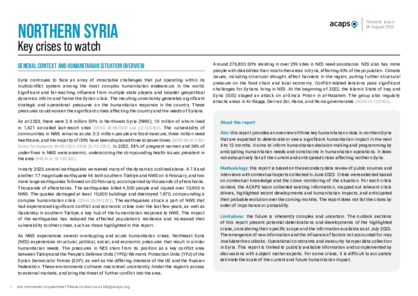Latest updates on country situation
12 March 2025
Between 7–10 March 2025, clashes erupted between forces of the Syrian caretaker government and supporters of the previous regime of Bashar Al Assad in Northwest Syria. The violence killed an estimated 1,000 people in the affected areas of Latakkie and Tartous governorates and displaced at least 45,000, who need shelter, food, medical aid, and protection. Insecurity restricts humanitarian access to the conflict area as aid workers fear abduction and physical threats. The fighting damaged six hospitals, several ambulances, and power lines. Many people have crossed to Akkar and Tripoli governorates in Lebanon, including at least 10,000 to Akkar. They take informal routes, as Israeli air strikes damaged the official border crossing during the escalation with Hezbollah in 2024. Issues include a lack of formal registration among new arrivals, a lack of organised aid, and heavy reliance on individual initiatives to provide aid for the new arrivals. (UN 10/03/2025, Sari Global 10/03/2025, TNA 09/03/3035)
19 February 2025
Since early December 2024, clashes in Menbij district in Aleppo governorate have been damaging the Tishreen Dam, rendering it non-operational. This has severely limited access to clean water and electricity for approximately 413,000 residents in Menbij and Kobani districts since 10 December. The dam and surrounding areas became a conflict hotspot after the Turkish-backed Syrian National Army initiated Operation Dawn of Freedom in early December, aiming to seize the area and the dam from the Kurdish-led Syrian Democratic Forces given its economic and strategic significance. Following the recent conflict escalation between the two groups, people in Menbij are experiencing limited access to basic services and essential goods, such as fuel, bread, and flour. Urgent needs also include the repair of the dam, as the risk of structural failure could cause catastrophic flooding that would affect over 40 downstream villages, especially if the dam sustains further attacks. (OCHA 12/02/2025, TNA 21/01/2025, CNN 13/12/2024)
04 December 2024
By 4 December 2024, hostilities between the Syrian army and opposition armed groups, notably Hayat Tahrir Al Sham, had intensified for a seventh consecutive day. Opposition armed groups have captured Aleppo, Syria's second-largest city, and are advancing into Hama city. Main routes in northwestern Syria are blocked, hindering humanitarian access and trapping civilians in conflict zones. The hostilities involve bombing and shelling, as well as Russian air strikes supporting the Syrian army, resulting in civilian casualties. Initial estimates indicate that at least 11,100 families (approximately 68,000 people) had been displaced by 2 December, though specific numbers remain unverified. Essential services such as healthcare, food, and water supply have been disrupted in Aleppo, Hama, and Idleb governorates. Humanitarian operations in those areas have also been severely disrupted. The Syrian Arab Red Crescent and Syrian Civil Defence (White Helmets) continue to provide assistance in their respective operational areas. (UNSC 03/12/2024, SARD 03/12/2024, OCHA 02/12/2024)
31 October 2024
Since October 2023, Turkish air strikes against Kurdish-led armed groups in northern Syria have intensified. Some have repeatedly targeted essential infrastructure, such as power and fuel plants, medical facilities, and agricultural resources. The latest series of significant attacks from 23–24 October 2024 in Al Hasakeh, Al Raqqa, and Aleppo governorates resulted in fatalities and extensive damage to critical infrastructure, affecting water and electricity access for over one million people. Around 1.2 million people in Al Hasakeh, 0.7 million people in Al Raqqa, and 3.5 million people in Aleppo are estimated to need humanitarian assistance throughout 2024. Overall, the intensification of attacks is affecting access to essential services and aggravating humanitarian needs, especially for WASH, health, and food. (NES NGO Forum 31/10/2024, HRW 26/10/2023, OCHA 03/03/2024)
22 October 2024
By 20 October 2024, intensified Israeli bombardments since 23 September had led approximately 425,000 individuals to flee to Syria from Lebanon, primarily via the Jdaidet Yabous border point on the road connecting Beirut and Damascus. The majority were women and children. An estimated 70% of the arrivals were Syrian, while 30% were Lebanese. Most of the displaced have settled in local reception centres or with host communities in Damascus, Homs, Rural Damascus, and Tartous governorates. Their immediate needs include free transportation from the border to the governorates, mobile clinics in areas of arrival, and essential supplies, such as food, water, and hygiene kits. In the coming months, the distribution of winter items and the provision of livelihood support will be crucial to help these refugees and returnees meet their basic needs. (UNHCR 20/10/2024, UNHCR 21/10/2024, Bahar 21/10/2024)
02 October 2024
By 1 October 2024, UNHCR had recorded over 128,000 individuals fleeing Lebanon to Syria since 27 September primarily because of Israeli bombardments. Most were women, children, and people with disabilities, and an estimated 50–60% were under 18. Their immediate needs include medical care and transportation. The Syrian Government has set up a few collective shelters in Homs, Lattakie, and Tartous for the arrivals. (UNHCR 01/10/2024](https://reliefweb.int/report/syrian-arab-republic/unhcr-syria-flash-update-5-response-displacement-lebanon-syria-reporting-period-24-30-september-2024), UNFPA 01/10/2024)
25 September 2024
By September 2024, around 8,000 internally displaced Syrians remained stranded in the isolated Rukban camp on Syria’s border with Jordan and Iraq. The camp is facing dire humanitarian conditions, with human rights organisations reporting severe shortages of food, water, and medication, as well as a lack of adequate medical facilities and staff. Both Syrian and Jordanian authorities highly restrict access to Rukban camp, with the US military maintaining de facto control over the area yet failing to provide adequate humanitarian assistance. The camp’s population drastically declined from more than 80,000 in 2016 to around 8,000 in September 2024 given these dire humanitarian conditions. Many of the camp residents were part of Syrian opposition groups or had defected from the Syrian security forces. Their return to Syrian Government-controlled areas puts them at risk of arbitrary detention, torture, and enforced disappearance, among other human rights violations. (AI 23/09/2024, Euro-Med Monitor 08/04/2022, SOHR 21/06/2024)
current crises
in
Syria
These crises have been identified through the INFORM Severity Index, a tool for measuring and comparing the severity of humanitarian crises globally.
SYR003 - Socioeconomic and Conflict Crisis
Last updated 27/03/2025
Drivers
Conflict
Socio-political
Violence
Displacement
Food Security
Crisis level
Country
Severity level
4.6 Very High
Access constraints
4.0
REG015 - Turkiye / Syria earthquake (regional crisis)
Last updated 19/06/2024
Drivers
Earthquake
Crisis level
Regional
Severity level
3.6 High
Access constraints
4.0
REG004 - Syrian Regional Crisis
Last updated 30/06/2024
Drivers
Crisis level
Regional
Severity level
4 High
Access constraints
4.0
Analysis products
on
Syria
06 January 2025
Syria: humanitarian impact overview (October–December 2024)
DOCUMENT / PDF / 2 MB
The Syria humanitarian impact overview is a quarterly publication that provides decision makers with a short, accessible overview of key trends and emerging challenges with the potential to affect humanitarian needs in Syria.
Attached resources
06 December 2024
Syria: escalation of conflict in the northwest
DOCUMENT / PDF / 445 KB
On 27 November 2024, the opposition group Hayat Tahrir Al Sham, launched an operation against Government of Syria in Aleppo. Within six days, the opposition had significantly expanded its territorial control. It is estimated that hundreds of civilians have been killed or injured. Escalating violence has displaced up to 178,000 people, severely affecting shelter, food security, healthcare, and access to education.
29 September 2023
Syria: Capacity-strengthening needs in NWS non-government-controlled areas
DOCUMENT / PDF / 290 KB
This report explores the capacity-strengthening needs of the local NGOs (LNGOs) headquartered and registered in Türkiye and the local responders operating in the nongovernment- controlled areas of Northwest Syria (NWS) – Idleb and northern Aleppo – following the February 2023 earthquake response and the July 2023 non-renewal of the UNSC cross-border resolution. The capacity-strengthening needs are categorised based on the three strategic pillars of the Humanitarian Leadership Academy (HLA).
04 August 2023
Northern Syria: key crises to watch
DOCUMENT / PDF / 1,016 KB
This report provides an overview of three key humanitarian crises in northern Syria that are expected to deteriorate or see a significant humanitarian impact in the next 6 to 12 months.






